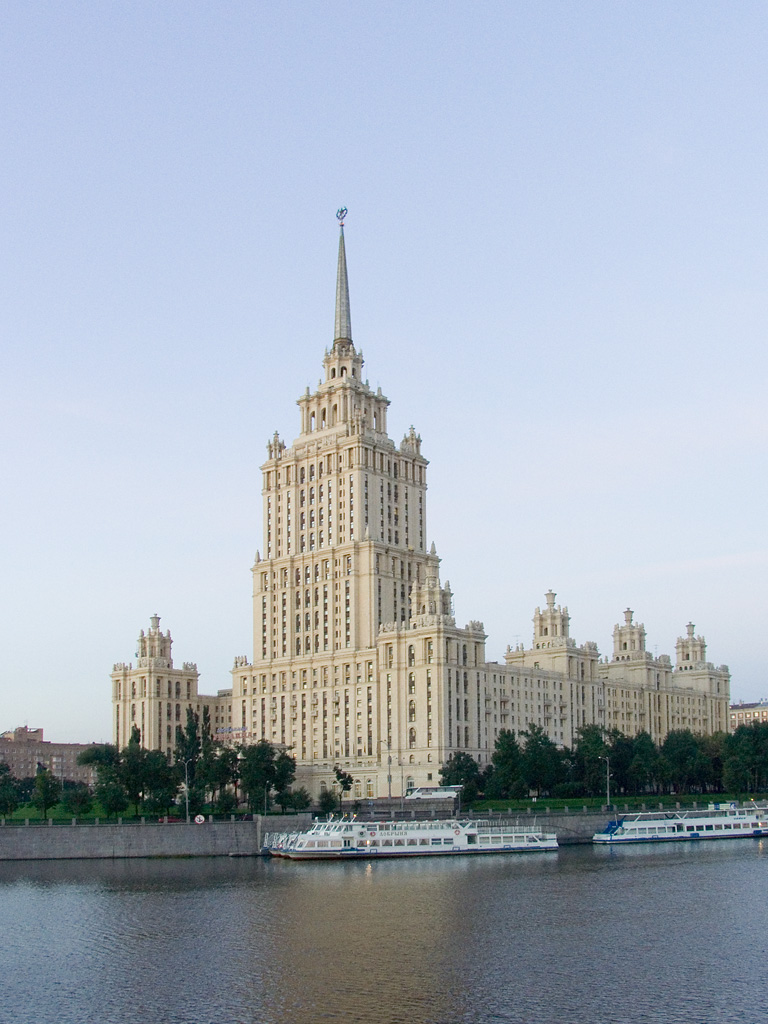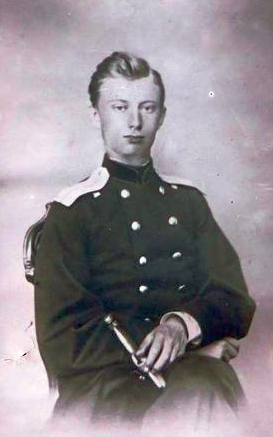|
Elektrozavodskaya (Moscow Metro)
Elektrozavodskaya () is a Moscow Metro station on the Arbatsko-Pokrovskaya Line in the Russian capital Moscow. It is one of the better-known stations of the system. Built as part of the third stage of the Moscow Metro and opened on 15 May 1944 during World War II, the station is one of the iconic symbols of the system, famous for its architectural decoration which is work of architects Vladimir Shchuko (who died whilst working on the station's project in 1939) and Vladimir Gelfreich, along with participation of his student Igor Rozhin. The station serves the Basmanny district and is located on the Bolshaya Semyonovskaya Street, next to the Yauza River. The railway station Elektrazavodskaya of the Kazan direction is also located nearby. In May 2007, the station was closed for a year during which the escalators were completely replaced, along with the floor panels. Most of the details and finishes including Motovilov's bas-reliefs were refurbished. The station was reopened o ... [...More Info...] [...Related Items...] OR: [Wikipedia] [Google] [Baidu] |
Moscow Metro Station
There are 308 active stations of the Moscow Metro. Of these, 271 on Moscow Metro proper, and some additional ones that are marketed by Moscow Metro: 6 stations of Moscow Monorail and 31 stations of the Moscow Central Circle. Two stations have been closed (the old Kaluzhskaya (closed), Kaluzhskaya and the old Pervomayskaya (closed), Pervomayskaya stations). By number of stations the Moscow Metro is ranked 8th, cf. List of metro systems. The deepest station of Moscow Metro, Park Pobedy, is the third-deepest metro station of the world. Active stations Physical characteristics Of the Moscow Metro's 236 stations, 80 are deep underground, 114 are shallow, and 42 (25 of them on the Central Circle) are at or above ground level. Of the latter there are 12 ground-level stations, four elevated stations, and one station (Vorobyovy Gory (Moscow Metro), Vorobyovy Gory) on a bridge. The deep stations comprise 55 Pylon station, triple-vaulted pylon stations, 19 Deep column station, triple-vaul ... [...More Info...] [...Related Items...] OR: [Wikipedia] [Google] [Baidu] |
Hammer And Sickle
The hammer and sickle (Unicode: ) is a communist symbol representing proletarian solidarity between industrial and agricultural workers. It was first adopted during the Russian Revolution at the end of World War I, the hammer representing workers and the sickle representing the peasants. After World War I (from which Russia withdrew in 1917) and the Russian Civil War, the hammer and sickle became more widely used as a symbol for labor within the Soviet Union (USSR) and for international proletarian unity. It was taken up by many communist movements around the world, some with local variations. The hammer and sickle remains commonplace in self-declared socialist states, such as China, Cuba, North Korea, Laos, and Vietnam, but also some former Soviet republics following the dissolution of the Soviet Union, such as Belarus and Russia. Some countries have imposed bans on communist symbols, where the display of the hammer and sickle is prohibited. History Worker symbolis ... [...More Info...] [...Related Items...] OR: [Wikipedia] [Google] [Baidu] |
Moscow Metro Stations
Moscow is the Capital city, capital and List of cities and towns in Russia by population, largest city of Russia, standing on the Moskva (river), Moskva River in Central Russia. It has a population estimated at over 13 million residents within the city limits, over 19.1 million residents in the urban area, and over 21.5 million residents in Moscow metropolitan area, its metropolitan area. The city covers an area of , while the urban area covers , and the metropolitan area covers over . Moscow is among the world's List of largest cities, largest cities, being the List of European cities by population within city limits, most populous city entirely in Europe, the largest List of urban areas in Europe, urban and List of metropolitan areas in Europe, metropolitan area in Europe, and the largest city by land area on the European continent. First documented in 1147, Moscow became the capital of the Grand Principality of Moscow, which led the unification of the Russian lan ... [...More Info...] [...Related Items...] OR: [Wikipedia] [Google] [Baidu] |
81-740/741
81-740/741 (Rusich, ), is a type of rolling stock specially designed for running under the harsh winter climate of outdoor Moscow. Rusich also features a corridor connection, allowing passenger access between the two sections of the cars. It was first designed for use on proposed light metro lines such as the Butovskaya line in Moscow (which ended up being the only light metro line built), being similar in nature to some high floor two-segment articulated trams like the rolling stock of the Los Angeles Metro Rail, the Tyne and Wear Metro, and Docklands Light Railway rolling stock in London. They are currently assigned to the metro lines including Sokolnicheskaya line, Sokolnicheskaya, Arbatsko-Pokrovskaya line, Arbatsko-Pokrovskaya, and Butovskaya line, Butovskaya lines of Moscow Metro, Kazan Metro. Four main types of Rusich rolling stock were manufactured. 81-740/741, 81-740.1/741.1; 81-740.4/741.4 which are used on the Moscow Metro and in Kazan Metro on the wide Russian gauge ... [...More Info...] [...Related Items...] OR: [Wikipedia] [Google] [Baidu] |
USSR State Prize
The USSR State Prize () was one of the Soviet Union’s highest civilian honours, awarded from its establishment in September 1966 until the dissolution of the USSR in 1991. It recognised outstanding contributions in the fields of science, mathematics, literature, the arts, and architecture. History State Stalin Prize (1941–1956) The award traces its origins to the State Stalin Prize (), commonly known as the Stalin Prize, which was established in 1941. It honoured achievements in science, technology, literature, and the arts deemed vital to the Soviet war effort and postwar reconstruction.Volkov, Solomon; Bouis, Antonina W., trans. 2004. ''Shostakovich and Stalin: The Extraordinary Relationship Between the Great Composer and the Brutal Dictator''. New York: Alfred A. Knopf. ISBN 0-375-41082-1. Ceremonies were suspended during 1944–45 and then held twice in 1946 (January for works from 1943–44; June for 1945 works). USSR State Prize (1966–1991) By 1966, the Stalin Prize h ... [...More Info...] [...Related Items...] OR: [Wikipedia] [Google] [Baidu] |
Stalinist Architecture
Stalinist architecture (), mostly known in the former Eastern Bloc as Stalinist style or socialist classicism, is the architecture of the Soviet Union under the leadership of Joseph Stalin, between 1933 (when Boris Iofan's draft for the Palace of the Soviets was officially approved) and 1955 (when Nikita Khrushchev condemned "excesses" of the past decades and disbanded the Soviet Academy of Architecture). Stalinist architecture is associated with the Socialist realism school of art and architecture. Features As part of the Soviet policy of rationalization of the country, all cities were built to a general urban planning, development plan. Each was divided into districts, with allotments based on the city's geography. Projects would be designed for whole districts, visibly transforming a city's architectural image. The interaction of the state with the architects would prove to be one of the features of this time. The same building could be declared a Formalism (art), formalist b ... [...More Info...] [...Related Items...] OR: [Wikipedia] [Google] [Baidu] |
Art Deco
Art Deco, short for the French (), is a style of visual arts, architecture, and product design that first Art Deco in Paris, appeared in Paris in the 1910s just before World War I and flourished in the United States and Europe during the 1920s to early 1930s, through styling and design of the exterior and interior of anything from large structures to small objects, including clothing, fashion, and jewelry. Art Deco has influenced buildings from skyscrapers to cinemas, bridges, ocean liners, trains, cars, trucks, buses, furniture, and everyday objects, including radios and vacuum cleaners. The name Art Deco came into use after the 1925 (International Exhibition of Modern Decorative and Industrial Arts) held in Paris. It has its origin in the bold geometric forms of the Vienna Secession and Cubism. From the outset, Art Deco was influenced by the bright colors of Fauvism and the Ballets Russes, and the exoticized styles of art from Chinese art, China, Japanese art, Japan, Indian ... [...More Info...] [...Related Items...] OR: [Wikipedia] [Google] [Baidu] |
Matvey Manizer
Matvey Genrikhovich Manizer (; – 20 December 1966) was a prominent Russian sculptor. Manizer created a number of works that became classics of socialist realism. Life Manizer was born in Saint Petersburg into the family of Genrikh Manizer (, ), a prominent Memel-born artist of Baltic German descent. As a student Manizer attended the Saint Petersburg State Artistic and Industrial Academy, and the art school of the Peredvizhniki from 1911 through 1916. From 1926 he was a member of the Association of Artists of Revolutionary Russia. In 1941 he moved to Moscow. Working in an academic and realistic style, Manizer produced a great number of monuments situated throughout the Soviet Union, including some twelve portrayals of Lenin. Manizer was awarded the People's Artist of the USSR (1958), Member of USSR Academy of Arts (1947), vice president of USSR Academy of Arts (1947-1966), chairman of the Saint Petersburg Union of Artists from 1937 to 1941, and three-time laure ... [...More Info...] [...Related Items...] OR: [Wikipedia] [Google] [Baidu] |
Alexander Stepanovich Popov
Alexander Stepanovich Popov (sometimes spelled Popoff; ; – ) was a Russian physicist who was one of the first people to invent a radio receiving device. declassified 8 January 2008 Popov's work as a teacher at a Russian naval school led him to explore high-frequency electrical phenomena. On 7 May 1895, he presented a paper on a wireless lightning detector he had built that worked via using a coherer to detect radio noise from lightning strikes. This day is celebrated today in Russia as Radio Day. In a 24 March 1896 demonstration, he transmitted radio signals 250 meters between different campus buildings in St. Petersburg. His work was based on that of another physicist, Oliver Lodge, and contemporaneous with the work of Guglielmo Marconi. Early life Born in the town of Krasnoturinsk, Sverdlovsk Oblast, in the Urals as the son of a priest, he became interested in natural sciences when he was a child. His father wanted Alexander to join the priesthood and sent him to ... [...More Info...] [...Related Items...] OR: [Wikipedia] [Google] [Baidu] |
Pavel Yablochkov
Pavel Nikolayevich Yablochkov (also transliterated as Jablochkoff; ; – ) was a Russian electrical engineer, businessman and the inventor of the Yablochkov candle, a type of electric carbon arc lamp. Biography Yablochkov graduated in 1866 as a military engineer from Nikolayev Engineering Institute, now Military Engineering-Technical University (Russian Военный инженерно-технический университет), and in 1869 from Technical Galvanic School in Saint Petersburg. After serving in the army, Yablochkov settled in Moscow in 1873, where he was appointed Head of Telegraph Office at the Moscow-Kursk railroad. He opened up a workshop for his experiments in electrical engineering, which laid down the foundations for his future inventions in the field of electric lighting, electric machines, galvanic cells and accumulators. Yablochkov’s major invention was the first model of an arc lamp that eliminated the mechanical complexity of competing light ... [...More Info...] [...Related Items...] OR: [Wikipedia] [Google] [Baidu] |
Michael Faraday
Michael Faraday (; 22 September 1791 – 25 August 1867) was an English chemist and physicist who contributed to the study of electrochemistry and electromagnetism. His main discoveries include the principles underlying electromagnetic induction, diamagnetism, and electrolysis. Although Faraday received little formal education, as a self-made man, he was one of the most influential scientists in history. It was by his research on the magnetic field around a Electrical conductor, conductor carrying a direct current that Faraday established the concept of the electromagnetic field in physics. Faraday also established that magnetism could Faraday effect, affect rays of light and that there was an underlying relationship between the two phenomena. the 1911 ''Encyclopædia Britannica''. He similarly discovered the principles of electromagnetic induction, diamagnetism, and the Faraday's laws of electrolysis, laws of electrolysis. His inventions of electric motor, electromagnetic rotar ... [...More Info...] [...Related Items...] OR: [Wikipedia] [Google] [Baidu] |



